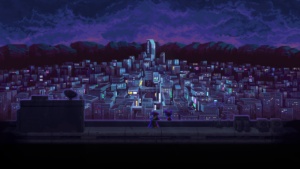Katana Zero felt like it burst suddenly from the shadows with its launch in April last year. Coming from developer Askiisoft, Justin Stander’s one-man team, the game surged to prominence, selling 100,000 copies on Switch alone in its first week of release.
This remarkable success saw the indie title jump to second place for the Switch store’s top sellers – beaten only by Cuphead’s Switch release on the same day, much to Stander’s (good natured) irritation: “It actually would have been the top seller on Switch for that entire month but Cuphead coming out stopped that. I mean, I definitely can’t complain, but it was a little bit annoying looking at the Switch store everyday to see where it’s at and it was always number two after Cuphead,” he told MCV/DEVELOP.
Stander’s Cuphead rivalry aside, it’s an excellent result for his first commercially-released game. Prior to Katana Zero, Stander had mostly worked on smaller, freeware titles, such as Pause Ahead and the critically acclaimed Tower of Heaven, both still available to be played via the Askiisoft website.
While Stander had received praise for his work, he realised that to really break into game development he’d have to move out of the freeware space.

“I had seen Terry Cavanagh’s game, VVVVVV come out and it made me realise that everyone really cares about a game when it’s being sold. Cavanagh had a very similar situation to me – before that he made a bunch of freeware games, and they didn’t get anywhere near the same attention as VVVVVV. And after that game, he continued to make a lot of freeware games, and they also didn’t get much attention. It really drove the point to me that if I wanted to really have a career in video games, I would have to make something that was sold. So I guess Katana Zero came out of this desire to make a much bigger, justifiably-sold commercial game.”
Of course, Katana Zero’s origins aren’t born entirely from the realities of capitalism, as Stander explains:
“I was really into making movies and I wanted to go to film school, but my parents didn’t think that was a proper plan for college. So I ended up going for a computer science degree, but I’d always been making games as a kid. I guess the idea was that I wanted to make something more narratively-driven, that paid homage to all my favourite storytelling tropes and expanded on them in my own way. Because I think first and foremost, Katana Zero is a storytelling game. That was definitely a big part of it: I had a story I wanted to tell.”
MAKING MURDER FEEL GOOD
Katana Zero’s inspirations may come as a surprise to many. We bring up the often-cited link to Dennaton Games’ Hotline Miami, as both games feature a similar live/die/repeat cycle, but Stander puts that one to rest.
“A lot of people say Hotline Miami, that seems to be the big one. Actually, I only played the game once, and it was several years prior – I didn’t remember a lot of it, though apparently some parts of it stuck with me.
“It was more like an adaptation of Samurai Gunn, which I felt was an extremely satisfying game. It really nailed making killing feel good, and a lot of that was about the one-hit kills. On top of that, it was trying to capture this feeling in Korean revenge thrillers where the main character is super fragile, but also goes out there and kills a lot of people. It’s sort of like this John Wick or Korean-revenge-thriller feeling where your main character is still just a person, but they’re also this incredible badass. I really wanted the player to feel that way, so a lot of the design pillars were focused around making the player feel badass mostly by making the challenge feel justified – so the success was earned.”
Stander’s urge to make killing feel exciting was born out of a frustration with modern games that he felt were too forgiving to players in pursuit of a power fantasy. “One of the big things was that enemies needed to feel as powerful as you are – otherwise, there’s no satisfaction in beating it. I wanted it to be that if you try to die, then it should be easy. Because that’s one thing I found really annoying.

“I think I was playing Payday, and I just wanted to see how fast it would take to die. So I did everything wrong: I ran out, I stood in front of the cops and let them pummel me with bullets. And after like five minutes, I still wasn’t dead. It just didn’t feel good. It felt like there’s no challenge. So yeah, the big thing is not to give a false sense of danger. I wanted it to be genuinely real and present at all times, even from the very beginning.”
So with both capitalism and murder in mind, Stander set to work. As an ambitious project from just one man, Katana Zero’s development took quite a while. So long in fact, that when we ask, Stander isn’t entirely sure.
“So uh, I think it was six years, but might have been five. Six years is what I’m usually sticking with but honestly, at this point, it’s been so long, it’s kind of hard to remember. The first few years were just simple prototyping. I was still in college at the time, so it was really just a small hobby thing at that point, until I graduated to work on it full time. The weird thing was definitely the budget, because I had never worked with a real budget before. I actually don’t think I’d ever worked with any budget before. Katana Zero was made on an extremely shoestring budget – the entire cost was somewhere around $60,000 which for a game like that is practically nothing. Most of it was just not paying myself at all and cutting down costs in my own life to do nothing but work on the game.”
Of course, under these tight restrictions, working (mostly) alone, Stander was bound to run into issues during development. While he had produced games in the past, putting together his first commercial title proved to be quite a challenge.
“It was kind of hard to really wrap my head around. With a small game, you can really obsess over the little details. It would end up taking me like a year of work just to make a short game that can be completed in 20-30 minutes. So trying to scale that up to a full experience with branching paths and more depth and meat to it ended up being this massive undertaking. I didn’t even begin to consider how big it was when I first set out on it. I think a lot of other indie developers have the same feeling where they think that their first commercial game is going to take two years or something, and then it ends up taking five or six years.”
THE ART OF KATANA ZERO
The scope of the project wasn’t the only issue. Following its release, a lot of Katana Zero’s praise has come from its gorgeous artstyle. The neon-drenched city of New Mecca perfectly complemented the narrative Stander had built his game around. The only issue? Stander, by his own admission, is very much not an artist.
“Artists are super hard to find as an indie developer. There was a period of like, two years, where I don’t think I had any artists working on the game. I just had to draw on what little things I could and I’m a terrible artist. So honestly, getting my art team at the very end was just a complete coincidence.”
In his hunt for artists, Stander went to TIGSource – an online independent developer community run by Spelunky’s Derek Yu, where the community can share their portfolios and collaborate on projects. It proved enormously helpful in putting the art for Katana Zero together, but it wasn’t without its issues.
“Finding high quality pixel artists and getting them to stick with your project is extremely difficult,” says Stander. “If you look at the the additional artists section of the credits on Katana Zero, you’ll see that there’s just a there’s a massive amount of artists that have worked on the game, way more than any other category. That’s because a lot of them would stick around for like a week or two weeks, and some that would only do like a day and then they quit, either because they have other projects, or they feel like the style isn’t their match, or just all sorts of other reasons.
“I used this big neon lighting effect,” Stander continues, “and that pretty much covered every single blemish that there could have been, because there are a lot of mismatched assets and styles in the game. But because everything has this cohesive neon glow, you can’t really tell that it’s all from different artists. That was a big lifesaver in the end.”
Whatever problems Stander had securing artists, it certainly didn’t hold Katana Zero back. On top of the incredible figure of 100,000 in its first week on Switch, the game has seen ongoing success on Steam.

“I’d say that Steam and Nintendo have both pushed it a large amount,” says Stander. “The big differences is that on Steam the user has a lot more control of sales – so the game has been on sale a lot more on Steam, and every time the game goes on sale, there’s this massive spike in buyers. Whereas on Switch it’s only ever been on sale twice in its entire life. So initially, the Switch version had way more buyers, but then that kind of petered out and now every time that there’s a Steam sale it spikes up and eventually Steam has caught up and surpassed Switch.”
Regardless of the platform though, Katana Zero has been a remarkable success story. So, despite Cuphead beating him to first place, how does Stander feel about the game’s reception, looking back?
“It really exceeded my expectations. I mean, it’s definitely done really well. It’s actually the 23rd highest rated game on Steam of all time right now. That really blows me away. It’s just been overwhelmingly positive.
“Obviously I kind of wish I could have finished the story in just one go, because it ends on a ‘To Be Continued.’ But even if I was to go back. I wouldn’t have cut down the story at all because I feel like everything that was in there I really trimmed down to its bare bones, just keeping the necessities. So if I had somehow cut it down into a much smaller project, just one small self-contained story, then I feel like it wouldn’t have had the same weight and impact.”
The game’s ‘To Be Continued’ ending actually inspired Stander’s advice for aspiring developers: limit your vision.
“Your game will take a lot longer than you expect to finish. And that’s fine. But keep your scope small, so you don’t end up spending over a decade on it, especially since you don’t know if it’s going to be successful in the first place. With Katana Zero, if I had finished the story all in one shot, I’d still be working right now. It was the right decision to end it where I did. Because otherwise – after working six years on a game, you question yourself so much about if it’s going to pay off, or if it’s worth all your time. If I was working 10 to 12 years on the game, that would be way worse. I’d maybe even end up scoping down the project too much, or ditching it entirely.”
So in the spirit of knowing when to bring things to an end, we leave it there. Stander is tight-lipped on the future for Katana Zero, but we’re sure he’ll be back for his final revenge against Cuphead.

 MCV/DEVELOP News, events, research and jobs from the games industry
MCV/DEVELOP News, events, research and jobs from the games industry




